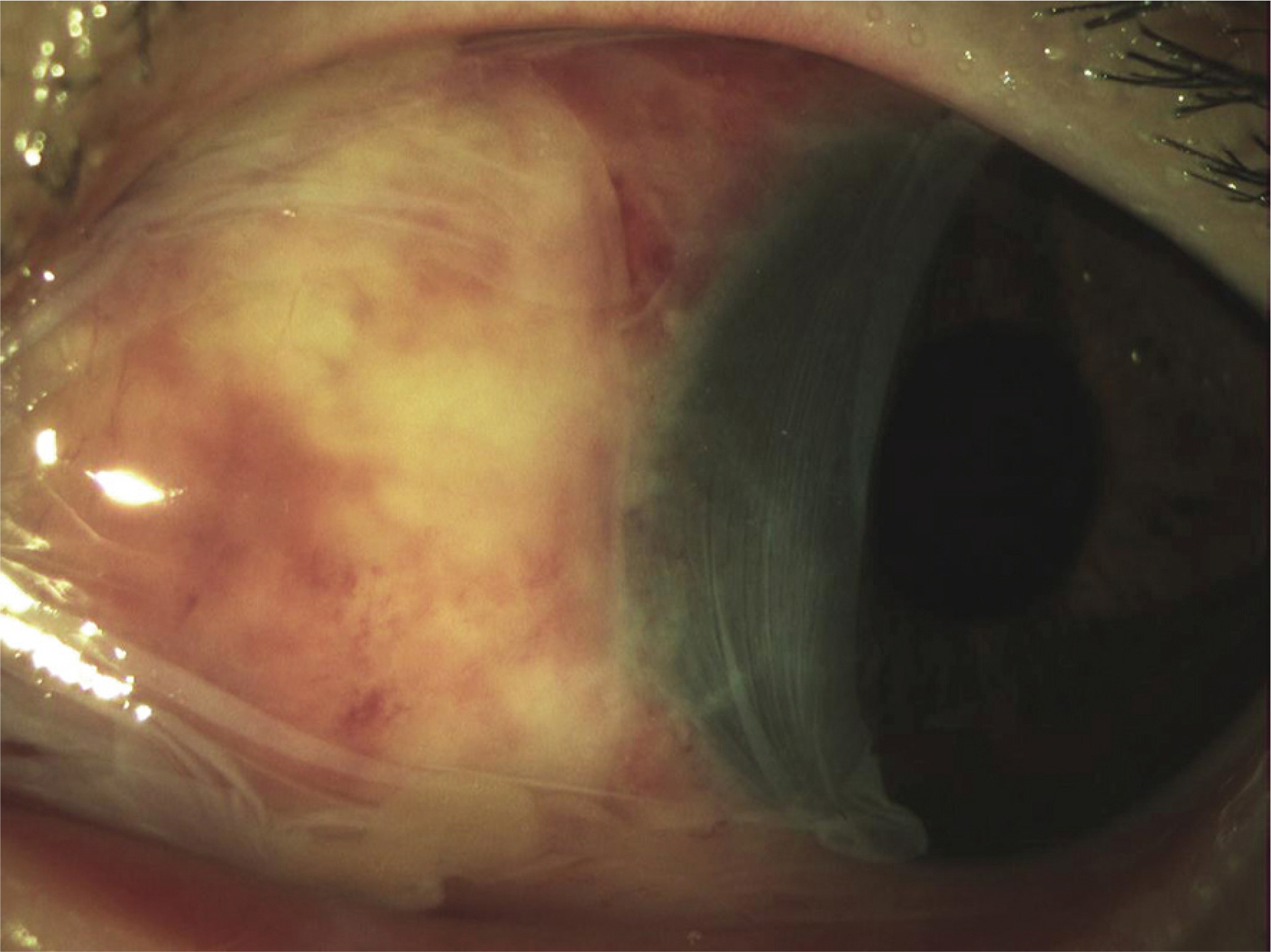J Korean Ophthalmol Soc.
2009 Jul;50(7):996-1004. 10.3341/jkos.2009.50.7.996.
Clinical Research on Effectiveness of Mitomycin C on Primary Pterygium With Limbal-Conjunctival Autograft
- Affiliations
-
- 1Cheil Eye Hospital, Daegu, Korea. eyepark9@dreamwiz.com
- KMID: 2212486
- DOI: http://doi.org/10.3341/jkos.2009.50.7.996
Abstract
- PURPOSE
To evaluate the effectiveness of Mitomycin C used as a combined therapy along with limbal-conjunctival autograft for primary pterygium. METHODS: Thirty eyes of 29 patients received Mitomycin C (0.02% MMC 3 minutes) with limbal-conjunctival autograft, and 30 eyes of 28 patients received limbal-conjunctival autograft alone. Recurrence and complications were evaluated in the patients at 2 weeks, 1, 3, 6 and 12 months postoperatively. RESULTS: Mean follow-up periods were 13.4+/-2.1 and 13.9+/-2.9 months, respectively. Between the two groups, recurrence in the conjunctiva or the cornea was not observed during the follow-up period. In the Mitomycin C use group, complications included a granuloma at the donor site (1 eye, 3.3%), wound dehiscence (2 eyes, 6.7%), and subgraft hemorrhage (2 eyes, 6.7%). In comparison, in the group treated with limbal-conjunctival autograft alone, complications included granuloma at the donor site (1 eye, 3.3%), pseudopterygium at the donor site (1 eye, 3.3%), wound dehiscence (3 eyes, 10%), and subgraft hemorrhage (2 eyes, 6.7%). CONCLUSIONS: The use of Mitomycin C as an adjuvant therapy has no significant effect on the recurrence rate in primary pterygium with limbal-conjunctival autograft.
MeSH Terms
Figure
Cited by 1 articles
-
Effectiveness of Mitomycin C Combined with Amniotic Membrane Transplantation to Treat Recurrent Pterygia
Young Hoon Jung, Byung Yi Ko
J Korean Ophthalmol Soc. 2018;59(3):217-222. doi: 10.3341/jkos.2018.59.3.217.
Reference
-
References
1. Dushku N, John MK, Schultz GS, Reid TW. Pterygia pathogenesis: corneal invasion by matrix metalloproteinase expressing altered limbal epithelial basal cells. Arch Ophthalmol. 2001; 119:695–706.2. Pinkerton OD. Immunologic basis for the pathogenesis of pterygium. Am J Ophthalmol. 1984; 98:225–8.
Article3. Lee SH, Jeong HJ. Immune reactions in pterygium. J Korean Ophthalmol Soc. 1987; 28:933–7.4. Baharassa F, Datta R. Postoperative beta irradiation treatment of pterygium. Int J Radiat Oncol Biol Phys. 1983; 9:679–84.5. Kunitomo N, Mori S. Studies on the pterygium. Report IV. A treatment of the pterygium by mitomycin C instillation. Nippon Ganka Gakkai Zasshi. 1963; 67:601–7.6. Hayasaka S, Noda S, Yamamoto Y, Setogawa T. Postoperative instillation of low dose mitomycin C in the treatment of primary pterygium. Am J Ophthalmol. 1988; 106:580–3.7. Frucht-Pery J, Siganos CS, Ilsar M. Intraoperative application of topical mitomycin C for pterygium surgery. Ophthalmology. 1996; 103:674–7.
Article8. Rubinfeld RS, Pfister RR, Stein RM, et al. Serious complications of topical mitomycin C after pterygium surgery. Ophthalmology. 1992; 99:1647–54.9. Hirst LW. The treatment of pterygium. Surv Ophthalmol. 2003; 48:145–80.
Article10. Kenyon KR, Wagoner MD, Hettinger ME. Conjunctival autograft transplantation for advanced and recurrent pterygium. Ophthalmology. 1985; 92:1461–70.
Article11. Gris O, Güell JL, del Campo Z, et al. Limbal-conjunctival autograft transplantation for the treatment of recurrent pterygium. Ophthalmology. 2000; 107:270–3.
Article12. Shimazaki J, Yang HY, Tsubota K. Limbal autograft transplantation for recurrent and advanced pterygia. Ophthalmic Surg Lasers. 1996; 27:917–23.
Article13. Al Fayez MF. Limbal versus conjunctival autograft transplantation for advanced and recurrent pterygium. Ophthalmology. 2002; 109:1752–5.
Article14. Park JM, Ahn HB, Park WC. The effect of combined amniotic membrane and limbal transplantation for recurrent pterygium or pseudopterygium. J Korean Ophthalmol Soc. 2003; 44:1504–11.15. Kilic A, Gurler B. The efficiency of limbal conjunctival autografting in pterygium surgery. Eur J Ophthalmol. 2006; 16:365–70.
Article16. Tan DT, Chee SP, Dear KB, et al. Effect of pterygium morphology on pterygium recurrence in a controlled trial comparing conjunctival autografting with bare sclera excision. Arch Ophthalmol. 1997; 115:1235–40.
Article17. Prabhasawat P, Barton K, Burkett G, Tseng SC. Comparison of conjunctival autografts, amniotic membrane grafts, and primary closure for pterygium excision. Ophthalmology. 1997; 104:974–85.
Article18. Verweij J, Pinedo HM. Mitomycin C: mechanism of action, usefulness and limitations. Anticancer Drugs. 1990; 1:5–13.19. Kenyon KR, Tseng SC. Limbal autograft transplantation for ocular surface disorders. Ophthalmology. 1989; 96:709–23.
Article20. Tseng SC. Concept and application of limbal stem cells. Eye. 1989; 3:141–57.
Article21. Wong VA, Law FC. Use of mitomycin C with conjunctival autograft in pterygium surgery in Asian-Canadians. Ophthalmology. 1999; 106:1512–5.
Article22. Mutlu FM, Sobaci G, Tatar T, Yildirim E. A comparative study of recurrent pterygium surgery: limbal conjunctival autograft transplantation versus mitomycin C with conjunctival flap. Ophthalmology. 1999; 106:817–21.
Article23. Frucht-Pery J, Raiskup F, Ilsar M, et al. Conjunctival autografting combined with low-dose mitomycin C for prevention of primary pterygium recurrence. Am J Ophthalmol. 2006; 141:1044–50.
Article24. Kim HH, Mun HJ, Park YJ, et al. Conjunctivolimbal autograft using a fibrin adhesive in pterygium surgery. J Korean Ophthalmol Soc. 2008; 22:147–54.
Article25. Barraquer JI. Etiology, pathogenesis, and treatment of the pterygium. Trans New Orleans Acad Ophthalmol. 1980; 167–78.26. Solomon A, Pires RT, Tseng SC. Amniotic membrane transplantation after extensive removal of primary and recurrent pterygia. Ophthalmology. 2001; 108:449–60.
Article27. Hirst LW. Prospective study of primary pterygium surgery using pterygium extended removal followed by extended conjunctival transplantation. Ophthalmology. 2008; 115:1663–72.
Article28. Bahar I, Kaiserman I, Weisbrod M, et al. Extensive versus limited pterygium excision with conjunctival autograft: outcomes and recurrence rates. Curr Eye Res. 2008; 33:435–40.
Article
- Full Text Links
- Actions
-
Cited
- CITED
-
- Close
- Share
- Similar articles
-
- The Clinical Results of Limbal Conjunctival Autograft Transplantation with Intraoperative Mitomycin C Application for Recurrent Pterygia
- Surgical Outcome of Primary Pterygium Excision with Conjunctival Autograft
- Limbal-Conjunctival Autograft Transplantation for the Treatment of Primary Pterygium
- Efficacy of Subconjunctival Bevacizumab Injection after Pterygium Excision with Limbal Conjunctival Autograft in Recurred Pterygium
- Analysis of Donor-site Complications after Conjunctivo-limbal Autograft to Treat Pterygium





